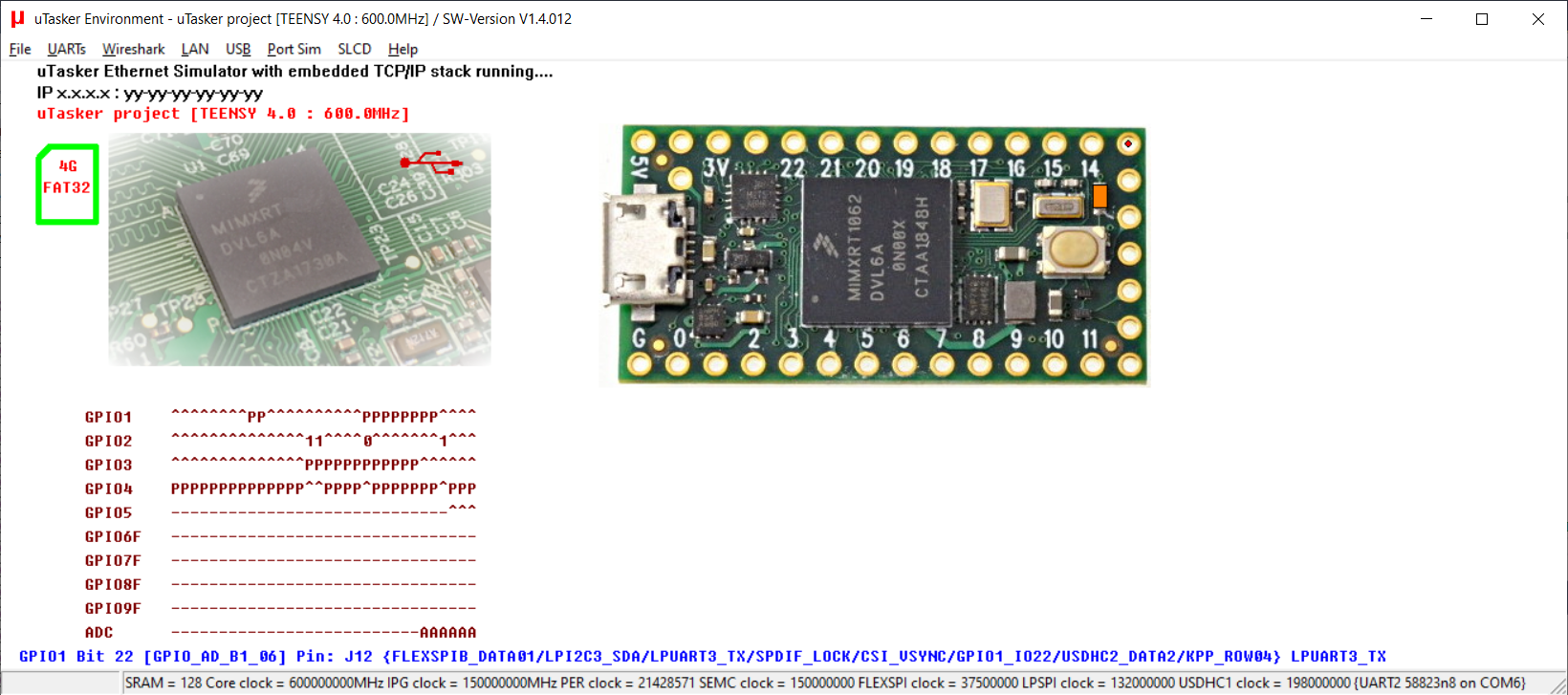Teensy 4.0

This board (including integrated USB loader, but not debugger, and available for around $20) is based on the MIMXRT1062DVL6A, which is the consumer version [0..95°C] of the 600MHz Cortex-M7 base part with double-precision VFPv5 FPU in MAPBGA196. It has 1M of internal RAM, dual-10/100M Ethernet, Dual-high speed USB (with integrated PHY), 8 low power UARTs, 4 I2C controllers, 3 synchronous audio interfaces, 2 SD card interfaces, 2 CAN interfaces, 2 FlexSPI interface (connected to 2MByte QSPI flash), 2 ADC, LCD and touch controller, a True Random Number Generator, plus various other features.
The processor's budget price for 10'000 pieces is $3.48 (low quantity distributor price for 100 pieces under $9), potentially making it very attractive for low cost products requiring connectivity, HDI, high processing performance and audio.
A 24MHz crystal on the board allows for accurate generation of up to 600MHz processor, 100MHz Ethernet and 480MHz USB clocks.
The µTasker target for the MIMXRT1060 allows immediate use of the board for various functions with simple control of performance/consumption as well as the ability to switch operation between this and other i.MX board/processors and Kinetis parts. Accurate simulation of the device in VisualStudio combined with integrated µTasker application functionality ensures reliable, low footprint product development solutions with minimum effort, risk and investment.
Teensy 4.0 Binaries
Here are some binary files that can be loaded to the Teensy 4.0. These were built using the µTasker applications (serial loader and V1.4 application) and can be simply generated using the supported compilers/IDEs [these were built using GCC], built using different configuration options or modified to suit specific requirements or hardware derived from this board :-
uTaskerSerialLoader_Teensy_4_0_USB-MSD_Kboot-HID_SREC-UART_SD-Card_AES256.hex [149k iHEX]
HS USB-MSD / KBOOT-HID composite USB bootloader, including SREC UART loader on the LPUART3 [LPUART3_RX on pin 16 and LPUART3_TX on pin 17] which can be loaded (copied to its QSPI-Flash) using the Teensy Loader.
This boot loader enables uploading applications by one of four methods:
- USB-MSD drag-and-drop onto the external hard drive that appears when the processor's USB is connected to a host PC
- KBOOT-HID (compatible with the NXP protocol and loading tools, such as KinetisFlashTool) via USB-HID
- SREC-UART (connected at 115'200Baud on LPUART3)
- SD-Card
This version of the serial loader supports either AES256 encrypted applications or non-encyrpted ones. In addition, the serial loader itself is stored in an AES256 encrypted form in the QSPI flash. The same application, in plain-text and encrypted forms are below, in order to allow testing this.
To force the loader when there is already an application installed, reset the board with the board's pin 0 connected to 0V. When operating, the green LED blinks at 5Hz. Beware that the SD card content will be checked for new firmware and the application will start after the check if it exists; to stay in the serial loader mode hold pin 0 with 0V for about 3..4s.
To quit the loader mode to start an installed application the USB-MSD driver can be simply ejected by the host. Alternatively the "go" command can be executed on the LPUART connection.
The serial loaders are described in the µTasker Serial Loader guide
-
uTaskerV1.4.12_Teensy_4_0_USB-SD-Card.bin [60.4k]
This Teensy 4.0 application shows SD card and USB-MSD / USB-CDC composite operation. It has a command-line menu on LPUART3 (at 115'200 Baud) or on USB-CDC with utFAT disk interface to control an SD card inserted in the board's optional socket. The disk interface is accessed via menu item 8 and offers a DOS-like user interface to display directories and files, plus advanced commands to view file details and read/write raw sectors on the disk:Disk interface =================== up go to main menu info utFAT/card info dir [path] show directory content dird [path] show deleted directory content dirh [path] show hidden content infof [path] show file info infod [path] show deleted info cd [path] change dir. (.. for up) comp compare [file1] with [file2] file [path] new empty file write [path] test write to file mkdir new empty dir rename [from] [to] rename trunc truncate to [length] [path] copy [file1] to [file2] hide [path] file/dir to hide unhide [path] file/dir to un-hide prot [path] file/dir to write-protect unprot [path] file/dir to un-protect print [path] print file content del [path] delete file or dir. sect [hex no.] display sector sectw [hex no.] [offset] [val] [cnt] help Display menu specific help quit Leave command mode
The SD card also appears as an external hard drive to the PC host. A second USB-MSD disk allows the viewing of memory (ITC, DTC and QSPI flash) based on FAT emulation as described in µTasker - FAT emulation
This unencrypted binary file can be loaded after installing the µTasker bootloader (above) via USB-MSD or KBOOT-HID. It can also be copied to the SD card and given the name "software.bin" so that it will be loaded by the serial loader.
-
uTaskerV1.4.12_Teensy_4_0_USB-SD-Card.srec [162k]
SREC formatted version of the application, which can be loaded by transferring via the LPUART3 interface. -
uTaskerV1.4.12_Teensy_4_0_USB-SD-Card_AES256.bin [60.4k]
This is the same Teensy 4.0 application but in an AES256 encrypted form. This can also be loaded in the same ways as the un-encrypted one, whereby the boot loader recognised whether it is encrypted or not and handles it accordingly. The encrypted version of the application ensures that it can't be retrieved from the QSPI flash and reverse engineered. -
uTaskerV1.4.12_Teensy_4_0_USB-SD-Card_AES256.srec [162k]
SREC formatted version of the AES256 encrypted application, which can be loaded by transferring via the LPUART3 interface.
Return to the i.MX RT landing page
µTasker Teensy 4.0 support. Copyright (c) 2004..2020 M.J.Butcher Consulting